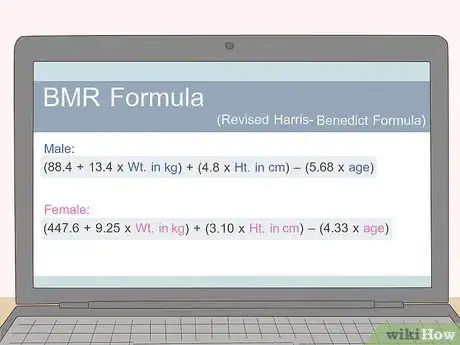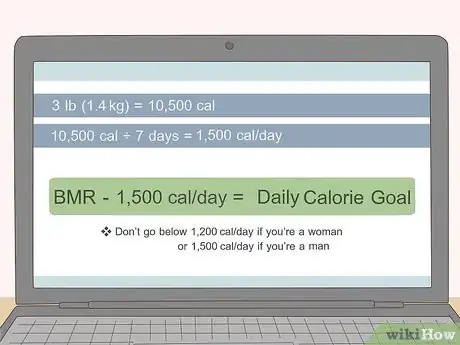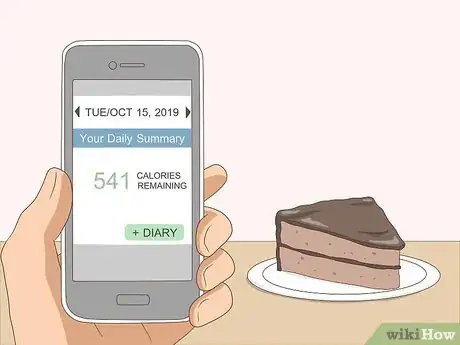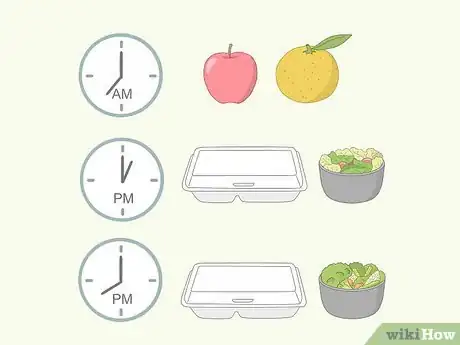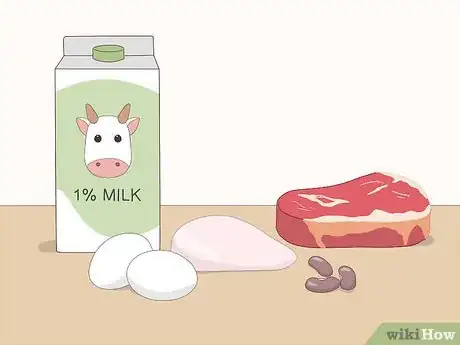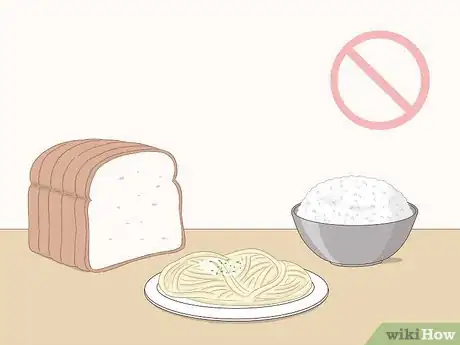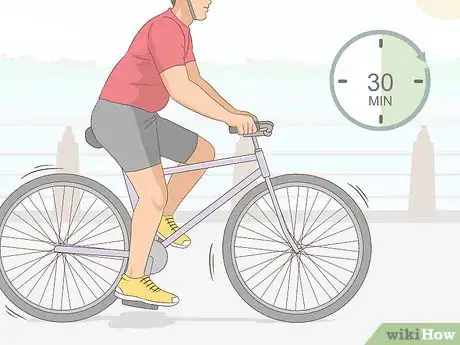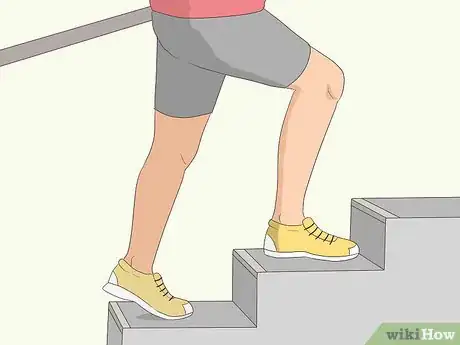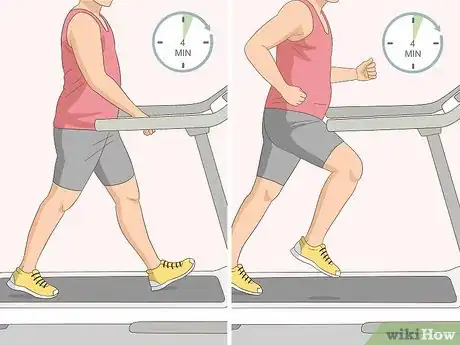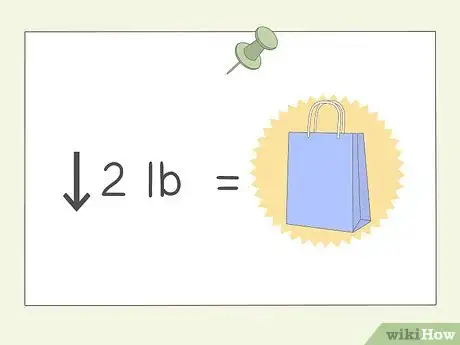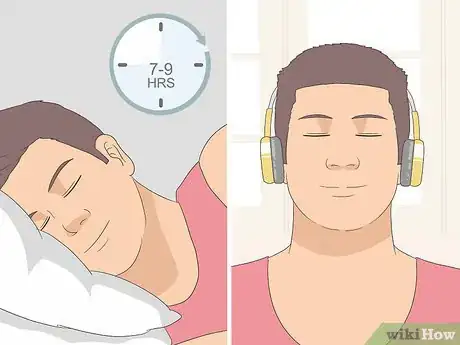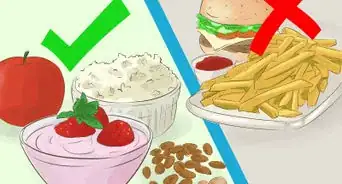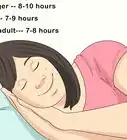This article was co-authored by Kristi Major. Kristi Major is an ACE (American Council on Exercise) certified Personal Trainer based in the San Francisco Bay Area. Kristi has over 18 years of personal training experience and more than 90 hours of recertification study in fitness, health, nutrition, and supplementation. She is CPR and AED certified from the American Heart Association and she has a BA in Television Broadcasting.
There are 12 references cited in this article, which can be found at the bottom of the page.
wikiHow marks an article as reader-approved once it receives enough positive feedback. In this case, 85% of readers who voted found the article helpful, earning it our reader-approved status.
This article has been viewed 574,020 times.
Losing 3 lb (1.4 kg) per week is a slightly faster rate than the recommended 1–2 lb (0.45–0.91 kg) per week, but it’s possible. First, talk to your doctor to determine a healthy weight for you. Then, figure out how many calories you’ll need to burn each day and create this deficit using a combination of healthy eating and exercise. To lose 3 lb (1.4 kg) per week as an ongoing goal, you’ll also need to find ways to stay motivated and energetic.
Steps
Adjusting Your Diet
-
1Find your basal metabolic rate. Before you can cut calories to lose 3 lb (1.4 kg) per week, you’ll need to know how many calories you typically burn in a day. This is called your basal metabolic rate (BMR) and you can use this as your baseline for deciding how many calories to eat each day and how many calories you will need to burn from exercise.[1]
- You can do the math to calculate your BMR, but it is quite complicated. You may find it easier to use an online calculator. There are many websites that have free calculators available.
- There are a few different formulas for calculating your basal metabolic rate and they’re all different. However, you’ll need to convert your height and weight into centimeters and kilograms. For example, to use the revised Harris-Benedict BMR equation as a man, you’d need to add 88.4 to 13.4 multiplied by your weight in kilograms, and then add this amount to 4.8 times your height in centimeters. Then, subtract 5.68 times your age from the total of these 2 sums.[2]
-
2Set a new daily calorie goal to create a 1,500 per day deficit. 3 lb (1.4 kg) is equal to 10,500 calories, which means you’ll need to cut 1,500 calories per day using diet and exercise. Once you know how many calories you burn in a day, subtract 1,500 from it to get your daily calorie goal. However, don’t go below 1,200 calories per day if you’re a woman or 1,500 per day if you’re a man.[3]
- For example, if your basal metabolic rate is 2,756, then you could eat up to 1,256 calories per day and you’d be creating a 1,500 per day deficit. This should result in a weight loss of 3 lb (1.4 kg) per week.
- If your basal metabolic rate is 2,300, then your calorie limit would only be 800 per day. However, this is too low, and you’d be at risk of developing health problems by eating such a low calorie diet, such as heart problems and gallstones.[4] Eat at least 1,200 calories per day and aim to burn an extra 400 calories per day from exercise.
Advertisement -
3Track your food with an app or food diary. The only way to ensure that you don’t exceed your daily calorie goal is to track everything you eat and drink each day using a tracking app or food diary. Make sure to measure everything you eat so that you will know how much of it you ate. Then, record the food in your tracker app or diary.[5]
Tip: If you use a food tracker app, it will total the calories you eat each day automatically. However, if you record your food intake manually, you’ll need to add the amounts up yourself. You can look up the amount of calories in your food online or get a calorie counts book to use as a reference.
-
4Eat more fruits and vegetables to cut back on calories. Fruits and vegetables are more nutrient dense than energy dense, which means they are high in fiber, vitamins, and minerals, but low in fat and calories. Aim to fill your plate halfway full of fruits and vegetables at every meal. This will help you to cut calories while staying satisfied and nourishing your body.[6]
- For example, you could have an apple and an orange with breakfast, include a green salad at lunch, and have some steamed vegetables with your dinner.
-
5Switch to lean protein and low-fat dairy. Lean protein and low-fat dairy products will help to keep you feeling full and satisfied while adding fewer calories than fattening meats and full-fat dairy products. Opt for skinless chicken breast, lean cuts of beef and pork, beans, tofu, and egg whites. When choosing dairy, opt for skim or 1% milk, low-fat cheese, and low-fat or no-fat yogurt.[7]
- Aim for 1 serving of lean protein or low-fat dairy at every meal. For example, you could have cereal with 1% milk on it for breakfast, a salad with grilled chicken for lunch, and a bowl of whole-wheat pasta with low-fat mozzarella and turkey meatballs for dinner.
-
6Reduce your intake of refined carbohydrates and sugar. White pasta, white rice, and white bread may have the same number of calories as their whole wheat counterparts, but they have been stripped of their fiber. This means that you won’t stay full for long after eating refined carbohydrates, and you might end up overeating.[8]
- Switch to whole wheat pasta, whole wheat bread, and brown rice to get more fiber in your diet.
Tip: Check the labels on any foods that you buy and avoid items that have added sugar, white flour, or other refined carbs and sugar.
-
7Try intermittent fasting for a more structured eating plan. Intermittent fasting is when you consume your meals and snacks within the same 8 to 10 hour window each day. This ensures that your digestive system gets a 14 to 16 hour break each day and helps you to naturally eat less since the time frame in which you can eat is limited.[9]
- Designate a time frame during the most active part of your day that works well for you. For example, you could eat between 7:00 am and 3:00 pm each day. Following this plan, you might have breakfast at 7:00 am, lunch at 11:00 am, and dinner at 2:45 pm.
- Or, you could eat between 10:00 am and 6:00 pm and have breakfast at 10:00 am, lunch at 2:00pm, and dinner at 5:30 pm.
Exercising to Burn More Calories
-
1Work in at least 30 minutes of cardiovascular exercise on most days. A total of 150 minutes of moderate cardiovascular activity is recommended for keeping you healthy. However, if you’re trying to lose weight, you may need to exercise more than this. Shoot for 30 minutes on 5 days of the week as your minimum target. This will help you to reach your 1,500 per day calorie deficit.[10]
- Choose an activity that you enjoy. This will help make it easier for you to stick with it.[11]
- Try breaking up your exercise sessions into smaller chunks if you’re short on time. For example, you could exercise for 10 minutes at a time 3 times per day, or do two 15 minute workouts each day if you don’t have time for a 30 minute workout session.
-
2Look for simple ways to get more steps in throughout the day. Every extra calorie you burn throughout the day will get you closer to your goal, so always be on the lookout for ways you can be more active. Some easy things you can do include:[12]
- Parking further away from entrances
- Getting off the bus or subway 1 or 2 stops early and walking the rest of the way
- Taking the stairs instead of the elevator
- Biking or walking when you run errands or on your way to school or work
- Doing pushups or squats during a commercial break when you’re watching TV
-
3Add high-intensity interval training to burn more calories. High-intensity interval training (HIIT) is an effective way to increase the amount of calories you burn during your workouts. To do it, alternate between exercising at a moderate pace and exercising vigorously, and then repeat these intervals. Try doing HIIT with walking, running, biking, or swimming.[13]
- A sample HIIT workout on a treadmill might include walking for 4 minutes, then running for 4 minutes, then walking for 4 minutes again, and so on for a total of 30 minutes of exercise.
- If you do HIIT on a bike, you might ride at a moderate pace for 4 minutes, then sprint for 3 minutes, then return to a moderate pace again for 4 minutes, and so on.
Tip: Check your local gym for HIIT classes. This is a great way to learn how HIIT works and burn calories in the process.
-
4Build muscle with resistance training. Building muscle gives you more lean muscle mass, which burns more calories. This will help to raise your metabolic rate and make it easier to create a caloric deficit. Aim for two 30 to 45 minutes strength training sessions per week.[14]
- You can use any type of equipment you like to build muscle. Try using resistance bands, dumbbells, strength-training machines, or go equipment-free and do bodyweight exercises.
- Make sure that you work all of your major muscle groups during each of your strength training sessions. The major muscle groups include your arms, legs, back, buttocks, abdomen, and chest.
Sticking with Your Plan
-
1Set realistic, short-term goals and reward yourself for meeting them. Usually, health professionals recommend a rate of 1–2 lb (0.45–0.91 kg) per week.[15] This rate of weight loss requires cutting 500 to 1,000 calories per day. If you find that after a week or so of trying to lose 3 lb (1.4 kg) per week you’re struggling to meet your goals, consider switching to 2 lb (0.91 kg). This will be a slightly easier goal to achieve, and hitting your goals will help you to stay motivated. You can also set up a reward system to help keep yourself motivated.[16]
- For example, you might promise yourself a small treat for each week that you hit your goal, such as getting a manicure, buying a new shirt, or going to the beach.
-
2Find support from friends and family. It can be hard to stay motivated if you don’t have anyone to share in your successes and challenges. Try telling at least one trusted friend or family member about our weight loss goal, and let them know how they can support you. This might be as simple as asking them not to offer you anything that’s not diet-friendly or to give you a call or text you once per week to get an update.[17]
- If you don’t have any family or friends who you’re comfortable talk with about our weight loss, look into a local support group or an online weight loss forum.
Tip: If you find it hard to stick with a diet or to change your habits around eating, working with a therapist may also be beneficial. They can teach you skills to resist emotional eating and be more mindful about the foods you eat.[18]
-
3Take good care of yourself. Practicing good self-care is another important part of maintaining a long-term weight loss program. If you’re hoping to lose 3 lb (1.4 kg) every week, you’ll need to maintain a positive mindset and ensure that you’re at your best. This will help you to stay on target with your eating and exercise targets and meet your weight loss goal each week. Some ways you can take care of yourself include: [19]
- Getting 7 to 9 hours of sleep every night
- Making time to do things you enjoy
- Reducing stress with relaxation techniques
Warnings
- Avoid crash diets and other dieting fads that seem dangerous. These may promise quick weight loss, but the results are not sustainable.⧼thumbs_response⧽
References
- ↑ https://www.mayoclinic.org/healthy-lifestyle/weight-loss/in-depth/weight-loss/art-20047752
- ↑ https://www.acefitness.org/certifiednewsarticle/2882/resting-metabolic-rate-best-ways-to-measure-it-and/
- ↑ https://www.mayoclinic.org/healthy-lifestyle/weight-loss/in-depth/weight-loss/art-20047752
- ↑ https://www.shape.com/healthy-eating/diet-tips/10-things-you-dont-know-about-calories
- ↑ https://www.mayoclinic.org/healthy-lifestyle/weight-loss/in-depth/weight-loss/art-20047752
- ↑ https://www.mayoclinic.org/healthy-lifestyle/weight-loss/in-depth/weight-loss/art-20047752
- ↑ https://www.mayoclinic.org/healthy-lifestyle/weight-loss/in-depth/weight-loss/art-20047752
- ↑ https://www.mayoclinic.org/healthy-lifestyle/weight-loss/in-depth/weight-loss/art-20047752
- ↑ https://www.health.harvard.edu/blog/intermittent-fasting-surprising-update-2018062914156
- ↑ https://www.mayoclinic.org/diseases-conditions/obesity/diagnosis-treatment/drc-20375749
- ↑ Kristi Major. ACE Certified Personal Trainer. Expert Interview. 29 October 2019.
- ↑ https://www.mayoclinic.org/diseases-conditions/obesity/diagnosis-treatment/drc-20375749
- ↑ https://www.ncbi.nlm.nih.gov/pmc/articles/PMC2991639/
- ↑ https://www.ncbi.nlm.nih.gov/pmc/articles/PMC2931407/
- ↑ Kristi Major. ACE Certified Personal Trainer. Expert Interview. 28 October 2019.
- ↑ https://www.mayoclinic.org/healthy-lifestyle/weight-loss/in-depth/weight-loss/art-20047752
- ↑ https://www.mayoclinic.org/diseases-conditions/obesity/diagnosis-treatment/drc-20375749
- ↑ https://www.mayoclinic.org/diseases-conditions/obesity/diagnosis-treatment/drc-20375749
- ↑ https://www.helpguide.org/articles/diets/how-to-lose-weight-and-keep-it-off.htm
- ↑ Kristi Major. ACE Certified Personal Trainer. Expert Interview. 29 October 2019.
- ↑ https://www.ncbi.nlm.nih.gov/pubmed/30335479
About This Article
To lose 3 pounds a week, try replacing any processed foods that you eat with healthier alternatives. For example, instead of eating spaghetti, try spaghetti squash instead. You can also substitute water for soda, sugary coffee, or alcohol, drinks that contain a lot of calories but have no nutritional value. If you can, spend 1 hour exercising every day. For example, you could go running or hiking. If you need to work up to that, start by walking during your lunch break and after work. To learn how to calculate whether you are eating the recommended amount of calories each day, read on!
